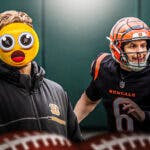The Cincinnati Bengals have been through a lot as a franchise, there really is no way around it. From struggling so badly on a yearly basis that they were ‘purposely’ kept off any Monday Night Football games, to becoming a completely inept franchise once the calendar flipped over to the year 2000, the orange and black have had their fair share of struggles.
But their successes have been quite high as well, as they appeared in two Super Bowls in the 1980s (even though they lost both to the San Francisco 49ers), they were spoiled by having the likes of Boomer Esiason and Ken Anderson as quarterbacks, and one of the best left tackles of all time, Anthony Munoz, was protecting them as well.
So with that being said, here are five of the greatest moments in the history of the Bengals franchise.
Bengals moments:
5. Corey Dillon etches his name in the NFL record books
Before the fateful matchup between the Bengals and the Denver Broncos took place in the 2000 NFL season, Walter Payton was the league leader in rushing yards in a single game with 276. After this game, Corey Dillon was able to be found at the top of that record, surprisingly enough.
The Broncos entered this game with the second-best rushing defense in the league, apparently, and the Bengals were winless at this point, falling in each of their first six games of the season – a recipe for disaster for Cincinnati.
But on the back of Dillon, the Bengals were able to right the ship, even though it looked like it was just a drop in the bucket of a disappointing 4-12 season.
The Bengals, who had apparently noticed that the Broncos’ defense was very aggressive, decided to rely on Dillon for the majority of the game, and he returned the favor, rushing for 278 yards on only 22 carries on a day that starting QB Akili Smith left the game with a neck injury and the offense only completed two passes for a measly 14 yards (including none after the first quarter?!?).
Dillon put together a really strong start to his career, as he had also rushed for 246 yards three years prior in his rookie season (giving him two of the then top-six rushing performances in one game), but his record was broken by Jamal Lewis three years later, which was then broken by Adrian Peterson, who still holds the record at 296 yards.
4. Kick returns can be the most exciting part of a game
In the 1989 Super Bowl, which the Bengals famously lost on a last-minute drive led by Joe Montana and those pesky 49ers, the Bengals ended up putting up the first TD of the game through an unconventional way – a kick return.
Stanford Jennings, who made his living as a backup running back and as a career special teams contributor, ran back a kick at the end of the third quarter 93 yards to make the score 13-6 in favor of the Bengals heading into the final quarter of the game.
While San Francisco did come back and score, winning the game 20-16, Jennings’ return gave the Bengals some glimmer of light in a game that was light on scoring and heavy on devastating injuries. The Bengals lost defensive star Tim Krumrie twisted his ankle 180 degrees (which snapped two bones in his leg), while the 49ers lost tackle Steve Wallace to a broken ankle.
This was the most recent SB that the Bengals have been a part of, and while they do not look ready to be going back anytime soon, this is a lasting memory that they can hold onto for a while.
3. Drafting the best left tackle – potentially ever
If a team needs to upgrade their offense, bringing in a generational talent at left tackle to protect their QB’s blind spot is a superb way to do it, just ask Anthony Munoz and the Bengals.
The 1980 draft united the Bengals and Munoz, who was coming out of USC and was taken third overall, behind Billy Sims and Lam Jones. One of three players from this draft voted into the NFL Hall of Fame, Munoz’s time with Cincinnati is one of the team’s bright spots from their earlier days.
Munoz went onto play all 13 seasons in the league with the Bengals, racking up 11 Pro Bowl and 9 First Team All-Pro nominations, including nine seasons that he earned both. From 1985 to 1990, Munoz earned six consecutive Pro Bowl and All-Pro nods, setting the stage for one of the, if not the, best career for a left tackle.
2. How to ‘Shuffle’ your way to a Super Bowl – a demonstration
In the 1988 season, fullback/running back Ickey Woods made a name for himself, both on and off the field, but in a good light. While his rushing performances helped lead this team to a 12-4 record and an SB appearance, his dance helped take over the world and gave fans a different aspect to appreciate this team for.
A few slight steps, followed up by switching the ball to a different arm, highlighted the ‘Ickey Shuffle,’ which was an easy dance for anyone to do, yet it also took over due to the fact that he had the opportunity to do it twice in the AFC Championship game against the Buffalo Bills, both times coming after he rushed for a touchdown.
His sixth 100-yard performance in the season, Woods helped lead an offensive attack that brought the Bengals one win away from eternal glory. This offense ran a ‘scary’ variation of the no-huddle offense, which the NFL did not take very kindly to (even though the league banned the no-huddle attack a few hours before game time, Steve Wyche’s offensive schemes remained intact, and the team executed them brilliantly).
1. Cold weather somehow brings out the best in teams (but only some)
You have the Ice Bowl between the Green Bay Packers and the Dallas Cowboys, and you have players like William ‘The Refridgerator’ Perry that use their stature to back up their cold nicknames. But the freezer also has its own spot in NFL history.
‘The Freezer Bowl,’ as it is affectionately known, paints a very cold (-59 degrees Fahrenheit) picture of the game between the Bengals and the San Diego Chargers. What ended up being the second-coldest game in NFL history went from what was expected to be a close game to one that was a blowout very quickly.
The Bengals, who earned a berth in their first-ever Super Bowl with this victory, dismantled the Chargers to the tune of a 27-7 romp, with the Chargers failing to rely on their high-flying passing attack, which included tight end Kellen Winslow, quarterback Doug Flutie, and wide receiver Charlie Joiner.
Cincinnati’s defense did its part too, forcing two turnovers and only allowing one score, so the unit’s 4-3 defense was gaining steam just at the right time, even though they did end up falling to the 49ers in this season’s Super Bowl.




